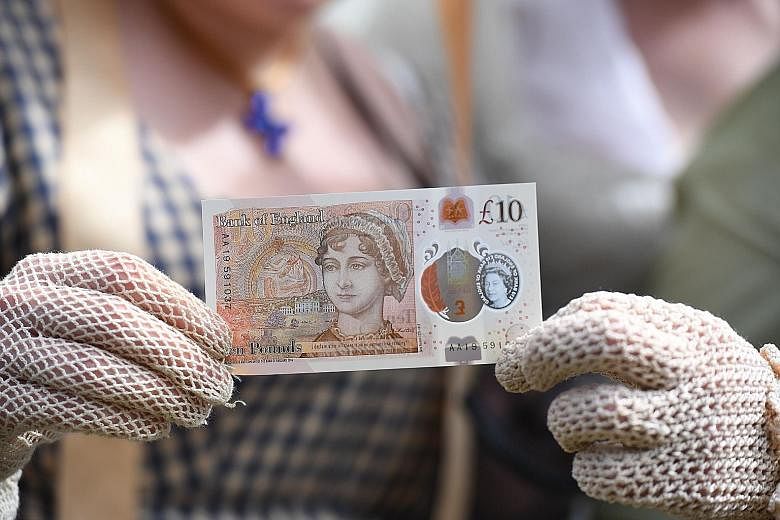LONDON (NYTIMES, REUTERS) - Queen Elizabeth II is the only woman now pictured on currency in England and Wales. That is about to change.
The Bank of England on Tuesday unveiled the final design for its first plastic £10 note bearing the likeness of novelist Jane Austen, timed to mark the 200th anniversary of her death.
The polymer bill, worth about S$17.80 at current exchange rates, will join the £5 polymer note featuring former prime minister Winston Churchill, which was introduced last year.
The central bank has printed an initial run of a billion of the new notes, which are known in Britain as "tenners".
Austen was buried in Winchester Cathedral in 1817 and completed many of her best-known works such as Pride And Prejudice and Emma in the nearby village of Chawton.
The governor of the Bank of England, Mr Mark J. Carney, said at the launch of the new note in Winchester: "Ten pounds would have meant a lot to Jane Austen, about the same as £1,000 would mean to us today."
Austen received a £10 publisher's advance for her first novel and the new banknote bears a quotation, "I declare after all there is no enjoyment like reading!" from her later work, Pride And Prejudice.
The quotation came from Caroline Bingley, a character who, in fact, had no interest in books and was merely trying to impress a potential suitor, Mr Darcy. It drew a mix of amusement and criticism in the media when it appeared on an initial design of the note in 2013.
Mr Carney defended the choice on Tuesday. "It captures much of her spirit, at least in my mind," he said.
"It draws out some of the essence of some of her social satire and her insight into people's character. So it works on multiple levels."
The new £10 bills, set to enter circulation in September, are made from a thin plastic material designed to last longer than traditional paper notes and able to withstand a washing machine cycle. Last year, Mr Carney famously dipped one of the new £5 notes into curry to show its durability.
"This added strength means notes will remain in good condition for longer, with a life span at least 21/2 times that of paper notes," he said of the £10 bill, which will be the first in Britain to have a tactile feature to help the blind and partially sighted.
The introduction of the new £5 notes was not without controversy. The bills used a tallow, or hard, fatty substance usually made from rendered meat, as part of their base. That angered vegetarians and vegans.
That tallow was also used in the new £10 notes already printed.
The bank has decided not to withdraw the bills in which the tallow was used. But it is considering using palm oil as the base for its next £20 note, which will feature painter J.M.W. Turner and is to enter circulation by 2020, as well as any reprints of its £5 and £10 bills.
There was an angry reaction when the Bank of England announced that Churchill would be featured on the £5 note, replacing prison reformer Elizabeth Fry and leaving England and Wales without a woman on its currency. Banks in Scotland and Northern Ireland print their own pound notes, with several featuring women.
Shortly after becoming the Bank of England governor in 2013, Mr Carney announced that Austen would replace scientist Charles Darwin on the £10 note. She becomes the fourth woman, including the queen, to be featured on notes issued by the Bank of England, compared with 14 men.

